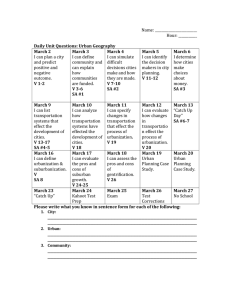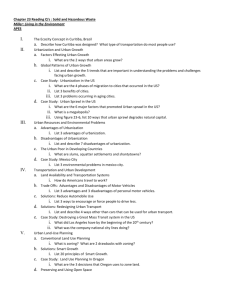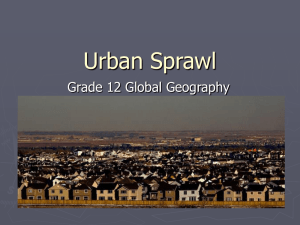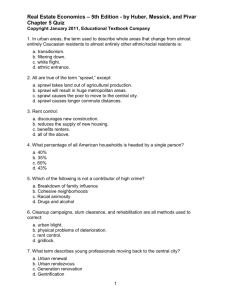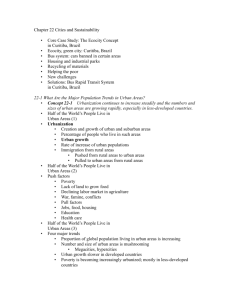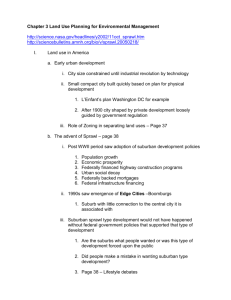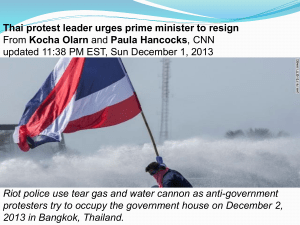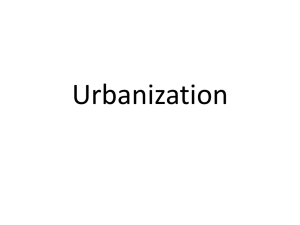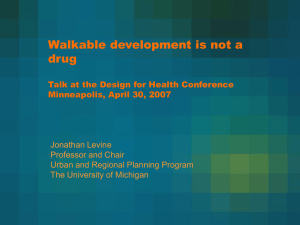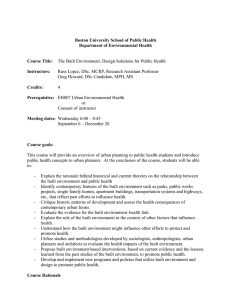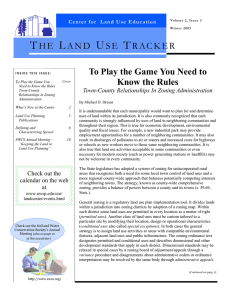File
advertisement
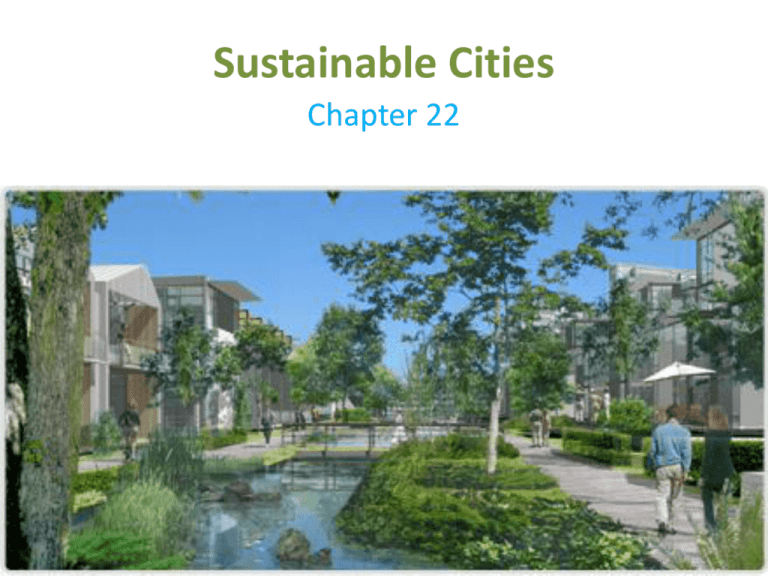
Sustainable Cities Chapter 22 Bus Rapid Transit System in Curitiba, Brazil Objective 1 What Are the Major Population Trends in Urban Areas? Half of the World’s People Live in Urban Areas • Urbanization – the creation and growth of urban areas • Urban growth – the rate of increase of urban populations – Occurs in 2 ways • Natural increase (more births than deaths) • Immigration from rural areas – Pushed from rural areas to urban areas – Pulled to urban areas from rural areas Four major trends – Proportion of global population living in urban areas is increasing – Number and size of urban areas is mushrooming • Megacities or megalopolises - 10 million or more people – Urban growth slower in developed countries – Poverty is becoming increasingly urbanized; mostly in developing countries Satellite Image of Major Urban Areas Throughout the World Typical Daily Traffic Jam of People, Carts, & Other Vehicles in Delhi, India Major Urban Areas in the United States Revealed by Satellite Images at Night Urban Sprawl Gobbles Up the Countryside • Urban sprawl – the growth of low-density development on the edges of cities and towns – It is eliminating surrounding agricultural and wild lands • Contributing factors to urban sprawl in the U.S. – 1st = Ample land – 2nd = Federal government loans – 3rd = Low-cost gasoline; highways – 4th = Tax laws encouraged home ownership – 5th = State and local zoning laws – 6th = Multiple political jurisdictions: poor urban planning Urban Sprawl in and around the U.S. City of Las Vegas, Nevada, from 1973 to 2000 U.S. Megalopolis of Bowash What are two ways in which this development might be harming the ecosystems along the Atlantic Coast? Objective 2 What Are the Major Urban Resource and Environmental Problems? Urbanization Has Economical Advantages • Centers of: – Economic development – Innovation – Education – Technological advances – Jobs • Environmental advantages – Recycling is more economically feasible • Funding for programs is higher in urban areas – More walking, mass transportation, and bicycling Urbanization Has Disadvantages • Huge ecological footprints – Urban areas only occupy 2% of the earth’s land area – Consume 75% of earth’s resources – Produce 75% of all carbon dioxide emissions • Lack vegetation – Most trees, shrubs, or other plants are destroyed to make way for parking lots and housing developments • Water problems – As cities grow, water demand increases – Reservoirs and canals must be built and deeper wells must be drilled Urban Areas Rarely Are Sustainable Systems Noise Levels of Some Common Sounds Life Is a Desperate Struggle for the Urban Poor in Developing Countries • Slums – areas dominated by tenements(apartments) and rooming houses where several people might live in a single room • Squatter settlements – people take over unoccupied land without the owners’ permission, simply because it is their only option for survival. • Shantytowns – Located on the outskirts of cities. Shacks made from corrugated(wavy/uneven) metal, plastic sheets, scrap wood, and other scavenged building materials. Extreme Poverty Forces Hundreds of Millions to Live in Slums Objective 3 How Does Transportation Affect Urban Environmental Impacts? Cities Can Grow Outward or Upward • Compact cities (Grow Upward – very little land) – Hong Kong, China – Tokyo, Japan – Mass transit • Dispersed cities (Grow Outward – lots of land) – U.S. and Canada – Car-centered cities Hong Kong, China upward growth Motor Vehicles Have Advantages & Disadvantages Advantages – Mobility and convenience – Jobs in • Production and repair of vehicles • Supplying fuel • Building roads – Status symbol • Power • Sex Appeal • Social Status Disadvantages – Largest source of outdoor air pollution • Causes 30,000 - 60,000 premature deaths a year – Accidents: death and injury • In the US 40,000 people per year are killed and another 300,000 people are severely injured • Globally 50 million wild animals and pets are killed annually – Helped create urban sprawl • 1/3rd of urban land is devoted to roads and parking lots • ½ of the urban land in the US is devoted to roads & parking lots – Traffic congestion • US motorist spend an average of 2 years of their lives in traffic jams Reducing Automobile Use Is Not Easy, but It Can Be Done • Full-cost pricing – Charge gasoline taxes to cover the harmful cost of driving • Difficult to pass in the United States – Strong public opposition – Mass transit: not an option in most cities – Dispersed nature of the U.S. (Outward not Upward) • What about a tax shift? – Reducing taxes on income, wages, and wealth to offset the increased taxes on gasoline • Raise parking fees • Raise fees on tolls, tunnels, and bridges that lead into major cities – Road congestion fees - $49.00/day in London, England • Car-sharing – Members reserve a car in advance or call the network and are directed to the closest car – Then they are billed monthly for their car use Write 1 advantage &1 disadvantage Write 1 advantage &1 disadvantage Potential Routes for High-Speed Bullet Trains in the U.S. and Parts of Canada Write 1 advantage & 1 disadvantage Write 1 advantage & 1 disadvantage Objective 4 How Important Is Urban Land Use Planning? Conventional Land-Use Planning Land-use planning – used to determine the best present and future use of each parcel of land – Encourages future population growth regardless of environmental and social consequences – Economic development – Revenues: property taxes • 90% of revenue for local governments comes from property taxes – Environmental and social consequences Zoning – various parcels of land are designated and protect areas from certain types of development – Mixed-use zoning • Allowing business to build in residential areas Smart Growth Works Smart growth - is one way to encourage more environmentally sustainable development by… – Reduces dependence on cars – Controls and directs sprawl – Cuts wasteful resource use Example: Conserving resources by reinvesting in existing infrastructure Pg 603 of text Preserving and Using Open Space Urban growth boundary – an urban growth line around each community and then allows no urban development outside those boundaries Municipal parks – large urban parks like Central Park in New York City Greenbelts – are an open area surrounding cities that are reserved for recreation, sustainable forestry, or other nondestructive uses Central Park, New York City, USA Objective 5 How Can Cities Become More Sustainable and Livable? New Urbanism Is Growing Conventional housing development has been to bulldoze a tract of woods or farmland and build rows of houses on standard-size lots and then name the street after the trees or wildlife they displaced. (examples: Oak Lane, Fox Fields, or Cedar Drive) Cluster development – high density housing units are built in a concentrated area and the rest of the land is used as a common area. New urbanism a.k.a. old villageism – – – – Walkability = everything located w/in a 10 minute walk Mixed-use and diversity = a mix of shops, offices, and apartments Quality urban design = emphasizing beauty and architectural aesthetics Environmental sustainability = development with minimal environmental impact – Smart transportation = well designed systems to connect neighborhoods, towns and cities Conventional and Cluster Housing Developments Cities for People Not Cars Ecocities = environmentally sustainable cities – Build and redesign for people not for cars – Use renewable energy resources – Recycle and purify water – Use energy and matter resources efficiently – Prevent pollution and reduce waste – Recycle, reuse and compost 60% of municipal waste – Protect and support biodiversity – Promote urban gardens and farmers markets – Zoning and other tools for sustainability The Ecovillage Movement Is Growing • Ecovillage movement – Small groups of people have come together to design and live in more sustainable villages and eco-hoods in rural, suburban, and urban areas. Summary List 5 tools used to promote smart growth.
